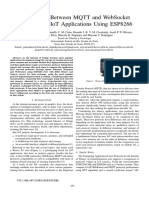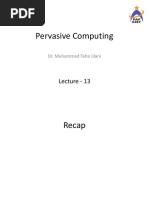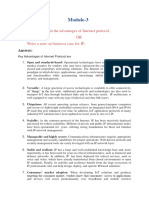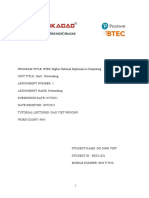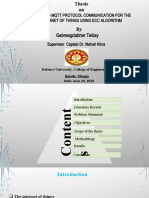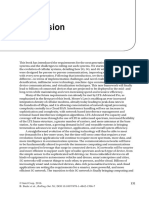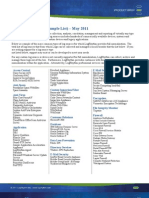MQTT CT295 Ctu
MQTT CT295 Ctu
Uploaded by
khoa.nphucnguyenCopyright:
Available Formats
MQTT CT295 Ctu
MQTT CT295 Ctu
Uploaded by
khoa.nphucnguyenOriginal Description:
Original Title
Copyright
Available Formats
Share this document
Did you find this document useful?
Is this content inappropriate?
Copyright:
Available Formats
MQTT CT295 Ctu
MQTT CT295 Ctu
Uploaded by
khoa.nphucnguyenCopyright:
Available Formats
19/04/2023
Chapter 4
Internet Network and Protocol
(Mạng Internet và Giao thức)
Software Engineering Dept., CICT,
Can Tho University
Lecturer: Trương Minh Thái
email: tmthai@ctu.edu.vn
Outline
PART 3
• TCP/IP Internet Protocol ?
• HTTP Protocol
• MQTT Protocol
– A scenario of IoT Application
– Message Queuing Telemetry Transport (MQTT)
– MQTT Message Format
Truong Minh Thai 1
19/04/2023
A scenario of IoT Application
• For example, consider low-cost temperature and relative humidity (RH) sensors sending
data over an LPWA LoRaWAN infrastructure. Temperature is represented as 2 bytes and
RH as another 2 bytes of data. This small data payload is directly transported on the
LoRaWAN MAC layer, without TCP/IP.
• The raw data for temperature and relative humidity can be decoded by the application.
While many constrained devices, such as sensors and actuators, have adopted
deployments with no application layer, this transportation method has not been
standardized. This lack of standardization makes it difficult for generic implementations of
this transport method to be successful from an interoperability perspective.
• A temperature value will always be present in the data transmitted by each sensor, but
decoding this data will be vendor specific. If you scale this scenario out across hundreds
or thousands of sensors, the problem of allowing various applications to receive and
interpret temperature values delivered in different formats becomes increasingly complex.
3
A scenario of IoT Application
• The solution to this problem is to use an IoT
data broker, as detailed in Figure 4.3.1. An IoT
data broker is a piece of middleware that
standardizes sensor output into a common
format that can then be retrieved by authorized
applications.
• Sensors X, Y, and Z are all temperature
sensors, but their output is encoded differently.
The IoT data broker understands the different
formats in which the temperature is encoded
and is, therefore, able to decode this data into a
common, standardized format. Applications A,
B, and C can access this temperature data
without having to deal with decoding multiple Figure 4.3.1 IoT Data Broker
4
temperature data formats. 4
Truong Minh Thai 2
19/04/2023
IoT Application Layer Protocols
• When considering constrained networks and/or
large-scale deployment of constrained nodes,
verbose web-based and data model protocols,
that may be too heavy for IoT applications
• To address this problem, the IoT industry is
working on new lightweight protocols that are
better suited to large numbers of constrained
nodes and networks. Two of the most popular
protocols are CoAP and MQTT.
• CoAP and MQTT are naturally at the top of this
sample IoT stack, based on an IEEE 802.15.4
mesh network. While there are a few
exceptions, you will almost always find CoAP Figure 4.3.2 Example of a High-Level IoT Protocol
Stack for CoAP and MQTT
deployed
5
over UDP and MQTT running over
5
TCP.
5
Outline
PART 3
• TCP/IP Internet Protocol ?
• HTTP Protocol
• MQTT Protocol
– A scenario of IoT Application
– Message Queuing Telemetry Transport (MQTT)
– MQTT Message Format
Truong Minh Thai 3
19/04/2023
Message Queuing Telemetry Transport (MQTT)
• At the end of the 1990s, engineers from IBM and Arcom were looking for a reliable,
lightweight, and cost-effective protocol to monitor and control a large number of sensors
and their data from a central server location, as typically used by the oil and gas
industries.
• Their research resulted in the development and implementation of the Message Queuing
Telemetry Transport (MQTT) protocol that is now standardized by the Organization for
the Advancement of Structured Information Standards (OASIS). (For more information on
OASIS, see www.oasis-open.org)
Message Queuing Telemetry Transport (MQTT)
• Protocol for minimal battery loss and
minimal bandwidth to connect with oil
pipelines via satellite.
• Enables a publish/subscribe messaging
model in an extremely lightweight way
• Core Features of MQTT
– Simple implementation – arbitrary
messages up to 256MB
– Quality of Service data delivery – in order
to deliver per publisher
– Lightweight and bandwidth efficient – little
client state, TCP/Websockets
Figure 4.3.3. Publish Subscribe Model
– Data agnostic
– Continuous session awareness. 8
Truong Minh Thai 4
19/04/2023
Message Queuing Telemetry Transport (MQTT)
• An MQTT client can act as a publisher to send data (or resource information) to an
MQTT server acting as an MQTT message broker.
Figure 4.3.4 MQTT Publish/Subscribe Framework 9
Message Queuing Telemetry Transport (MQTT)
• The MQTT client on the left side publishes its data (Temperature and
Relative Humidity …)
• The MQTT server (or message broker) accepts the network
connection along with application messages, such as Temp/RH data,
from the publishers. It also handles the subscription and
unsubscription process and pushes the application data to MQTT
clients acting as subscribers.
• The application on the right side is an MQTT client that is a
subscriber to the Temp/RH data being generated by the publisher or
sensor on the left. This model, where subscribers express a desire to
receive information from publishers, is well known.
• With MQTT, clients can subscribe to all data (using a wildcard
character) or specific data from the information tree of a publisher.
The presence of a message broker in MQTT decouples the data
transmission between clients acting as publishers and subscribers. 10
10
Truong Minh Thai 5
19/04/2023
Client, Broker and Connection Establishment
• Client:
– any device (from a microcontroller up to a full-fledged server) that runs an MQTT library
and connects to an MQTT broker over a network. Any device that speaks MQTT over a
TCP/IP stack can be called an MQTT client.
– MQTT client libraries are available for a huge variety of programming languages. For
example, Android, Arduino, C, C++, C#, Go, iOS, Java, JavaScript, and .NET.
• Broke :
– responsible for receiving all messages, filtering the messages, determining who is
subscribed to each message, and sending the message to these subscribed clients.
– holds the session data of all clients that have persistent sessions, including subscriptions
and missed messages.
– authentication and authorization of clients
11
MQTT Connection
• MQTT protocol is based on TCP/IP.
Both the client and the broker need to
have a TCP/IP stack.
• MQTT connection is always
between one client and the
broker. Clients never connect
to each other directly
12
Truong Minh Thai 6
19/04/2023
MQTT Packet Components
• ClientId: identifies each MQTT client that connects to an MQTT
broker. The broker uses the ClientId to identify the client and the
current state of the client.Therefore, this Id should be unique per
client and broker.
• Clean Session: The clean session flag tells the broker whether
the client wants to establish a persistent session or not. In a
persistent session (CleanSession = false), the broker stores all
subscriptions for the client and all missed messages for the client.
• Username/Password : MQTT can send a user name and
password for client authentication and authorization.
• Will Message: notifies other clients when a client disconnects
ungracefully.
• KeepAlive: time interval in seconds that the client specifies and
communicates to the broker when the connection established. It
defines the longest period of time that the broker and client can
endure without sending a message.
13
Broker Response
• Session Present flag: The session present flag tells the client
whether the broker already has a persistent session available
from previous interactions with the client.
• Connect return code: tells the client whether the connection
attempt was successful or not. ( 0 = connection accepted )
14
Truong Minh Thai 7
19/04/2023
Publish
• MQTT client can publish messages as soon as it connects to a
broker.
• MQTT utilizes topic-based filtering of the messages on the
broker
• Each message must contain a topic that the broker can use to
forward the message to interested clients. Typically, each
message has a payload that contains the data to transmit in byte
format.
• The use case of the client determines how the payload is
structured.
• The sending client (publisher) decides whether it wants to send
binary data, text data, or even full-fledged XML or JSON.
15
Publish Message Components
• Topic Name: a simple string that is hierarchically structured with forward slashes as delimiters. For
example, “myhome/livingroom/temperature”
• QoS: indicates the Quality of Service Level (QoS) of the message. There are three levels: 0, 1, and
2. The service level determines what kind of guarantee a message has for reaching the intended
recipient (client or broker)
• Retain Flag: defines whether the message is saved by the broker as the last known good value for
a specified topic. When a new client subscribes to a topic, they receive the last message that is
retained on that topic.
• Payload: actual content of the message. MQTT is data-agnostic. It is possible to send images, text
in any encoding, encrypted data, and virtually every data in binary.
• Packet Identifier: uniquely identifies a message as it flows between the client and broker. The
packet identifier is only relevant for QoS levels greater than zero. The client library and/or the broker
is responsible for setting this internal MQTT identifier.
• DUP flag: indicates that the message is a duplicate and was resent because the intended recipient
(client or broker) did not acknowledge the original message. This is only relevant for QoS greater
than 0
16
Truong Minh Thai 8
19/04/2023
Subscribe
• Publishing a message doesn’t make sense if no one ever
receives it. In other words, if there are no clients to subscribe
to the topics of the messages. To receive messages on topics
of interest, the client sends a SUBSCRIBE message to the
MQTT broker. This subscribe message is very simple, it
contains a unique packet identifier and a list of subscriptions.
• Packet Identifier: uniquely identifies a message as it flows
between the client and broker. The client library and/or the
broker is responsible for setting this internal MQTT identifier.
• List of Subscriptions: A SUBSCRIBE message can contain
multiple subscriptions for a client. Each subscription is made
up of a topic and a QoS level. The topic in the subscribe
message can contain wildcards that make it possible to
subscribe to a topic pattern rather than a specific topic. If
there are overlapping subscriptions for one client, the broker
delivers the message that has the highest QoS level for that
topic
17
Subscribe Acknowledgement
• Packet Identifier: unique identifier used to identify
a message, same as in the SUBSCRIBE msg.
• Return Code: The broker sends one return code
for each topic/QoS-pair that it receives in the
SUBSCRIBE message.
18
Truong Minh Thai 9
19/04/2023
Unsubscribe
19
Outline
PART 3
• TCP/IP Internet Protocol ?
• HTTP Protocol
• MQTT Protocol
– A scenario of IoT Application
– Message Queuing Telemetry Transport (MQTT)
– MQTT Message Format
20
20
Truong Minh Thai 10
19/04/2023
MQTT Message Format
• MQTT control packets run over a TCP
transport using port 1883. TCP ensures an
ordered, lossless stream of bytes between
the MQTT client and the MQTT server.
Optionally, MQTT can be secured using
TLS on port 8883, and WebSocket (defined
in RFC 6455) can also be used.
• MQTT is a lightweight protocol because
each control packet consists of a 2-byte
fixed header with optional variable header
fields and an optional payload. A control
packet can contain a payload of up to 256
MB
Figure 4.3.5. MQTT Message Format
21
21
MQTT Message Format
• MQTT control packets run over a TCP transport
using port 1883. TCP ensures an ordered,
lossless stream of bytes between the MQTT client
and the MQTT server. Optionally, MQTT can be
secured using TLS on port 8883, and WebSocket
(defined in RFC 6455) can also be used.
• MQTT is a lightweight protocol because each
control packet consists of a 2-byte fixed header
with optional variable header fields and optional
payload. A control packet can contain a payload
up to 256 MB
Figure 4.3.5. MQTT Message Format
22
22
Truong Minh Thai 11
19/04/2023
MQTT Message Format
- MQTT Control header
• The first MQTT field in the header is Message
Type, which identifies the kind of MQTT packet
within a message.
• Fourteen different types of control packets are
specified in MQTT version 3.1.1. Each of them
has a unique value that is coded into the
Message Type field. Note that values 0 and 15
MQTT Message Types 23
are reserved
23
MQTT Message Format
- MQTT Control header
• The next field in the MQTT header is DUP (Duplication Flag). This flag, when set, allows the client to
notate that the packet has been sent previously, but an acknowledgment was not received.
• The QoS header field allows for the selection of three different QoS levels. The MQTT protocol offers
three levels of quality of service (QoS).
• The next field is the Retain flag. Only found in a PUBLISH message, the Retain flag notifies the
server to hold onto the message data. This allows new subscribers to instantly receive the last
known value without having to wait for the next update from the publisher. 24
24
Truong Minh Thai 12
19/04/2023
MQTT Message Format
- MQTT Control header
Control Flag bits
25
25
MQTT Message Format
- Remaining Length
• This field specifies the number of bytes in the
MQTT packet following this field.
• The remaining length is the number of bytes
following the length field, including variable
length header and payload as illustrated.
• This is of variable length between 1 and 4
bytes.
• Each byte uses 7 bits for the length with the
MSB used as a continuation flag.
• If the continuation flag bit of a byte is 1, it means
the next byte is also part of the remaining
length. And if the continuation flag bit is 0, it
means that the byte is the last one of the
remaining length.
26
26
Truong Minh Thai 13
19/04/2023
MQTT Message Format
- Remaining Length
• A packet length of 321 bytes requires a 2-byte
• The remaining Packet length 64 bytes of remaining length field:
requires only 1 byte:
27
27
MQTT Message Format
- Variable header
• A variable header is not present in all the MQTT packets. Some MQTT commands or messages
use this field to provide additional information or flags and they vary depending on the packet type.
A packet identifier is common in most packet types.
28
28
Truong Minh Thai 14
19/04/2023
MQTT Message Format
- Payload
• In the end, the packet may contain a payload. Even the payload is optional and varies with the type
of packet. This field usually contains the data which is being sent.
29
29
MQTT CONNECT packet
• The first byte of the connect packet will be 10.
Because the value of CONNECT command is 1, the
first 4 MSB will be 1 and there are no flags so the
next 4 bits will be 0.
• The second byte should be the remaining length. which is the length of the variable header and the
length of the payload. Let us decide this length after completing the variable header and payload.
https://openlabpro.com/guide/mqtt-packet-format/ 30
30
Truong Minh Thai 15
19/04/2023
MQTT CONNECT packet
• The second byte should be the remaining length. which is the length of the variable heaIn the variable header, first, there
should be the protocol name. And for this, the first 2 bytes should mention the length of the protocol name followed by the
protocol name. In our case, the protocol name is MQTT which is of length 4.
• After the protocol name, there is the protocol level. This determines which version of MQTT it supports. For version 3.1.1, the
protocol is level 4.
• After that, there is the connect flag byte.
• The next two bytes are used to mention the keep-alive duration in seconds. For 60 seconds, the value will be 003C in hex.
• After the variable header, there will be the payload and which will contain; the client id, username, and password. In our case
there is no username and password, so only the client Id will be present. Same as we did for the protocol name, the first 2
bytes will denote the client id length. Let’s assume our client id is PQRST.
• der and the length of the payload. Let us decide this length after completing the variable header and payload. 31
31
MQTT CONNECT packet
To determine the ‘remaining length’ which is supposed to be here. If you count the total bytes used for the
variable header and payload. It is 17. Therefore the ‘remaining length will’ be 17.
32
32
Truong Minh Thai 16
19/04/2023
MQTT PUBLISH packet
Publish the message “HELLO” to the topic OPENLABPRO.
• For the publish packet command value is 3. With QoS level 0 and without retaining the
message control flag will be 0. In the variable header section, the first 2 bytes will denote the
length of the topic and then be followed by the topic. In a similar way in payload, the section's
first 2 bytes will denote the length of the message which is followed by the message.
https://openlabpro.com/guide/mqtt-packet-format/ 33
33
MQTT SUBSCRIBE packet
• To subscribe to a topic the client has to send the SUBSCRIBE packet.
• The command value of Subscribe packet is 8 and the Control flag is reserved and should be 2.
• The variable header will contain a non-zero 16-bit packet ID. And as payload, there will be a topic
to subscribe to follow by the requested QOS level.
To subscribe to the topic OPENLABPRO with QOS 0:
34
34
Truong Minh Thai 17
19/04/2023
MQTT Vs. HTTP
MQTT HTTP
Purpose Messaging Documents
Protocol Efficiency High Average
Power Efficiency Yes No
Client Languages Many Many
35
Mosquitto MQTT Broker
• Mosquitto : lightweight open source message broker Implements MQTT versions 3.1.1, 3.1,
and version 5.0. Main website : https://mosquitto.org/
Totorials:
• https://www.switchdoc.com/2018/02/tutorial-installing-and-testing-mosquitto-mqtt-on-
raspberry-pi/
36
Truong Minh Thai 18
19/04/2023
Q&A
37
Truong Minh Thai 19
You might also like
- Network and Security Lab Report: Lab 4.1: Installing Certificate ServicesDocument67 pagesNetwork and Security Lab Report: Lab 4.1: Installing Certificate Serviceslucifer thomasNo ratings yet
- Understanding The Road Map of 5G, and 6G NetworksDocument6 pagesUnderstanding The Road Map of 5G, and 6G Networkssenna.glrrNo ratings yet
- CoAP in IOTDocument9 pagesCoAP in IOTmalvika kumarNo ratings yet
- Case Study I WiresharkDocument5 pagesCase Study I WiresharkAnooj ShahNo ratings yet
- Prayogo 2019Document5 pagesPrayogo 2019dhonimahendrasingh360No ratings yet
- Iot Unit 4Document53 pagesIot Unit 4SRHNo ratings yet
- MQTT WorkDocument9 pagesMQTT WorkMuhammad syifa Sy1f4No ratings yet
- Unit - 3 NotesDocument48 pagesUnit - 3 NotesAnish RajNo ratings yet
- IoT_Module-2Document66 pagesIoT_Module-2soumyaks81No ratings yet
- CPE 445-Internet of Things - Chapter 6Document44 pagesCPE 445-Internet of Things - Chapter 6fa20-bce-046No ratings yet
- Bscit Sem 6 Iot Material Unit 4Document11 pagesBscit Sem 6 Iot Material Unit 4paratevedant1403No ratings yet
- Comparison Between MQTT and Websocket Protocols For Iot Applications Using Esp8266Document6 pagesComparison Between MQTT and Websocket Protocols For Iot Applications Using Esp8266Victor HugoNo ratings yet
- Presentation of NetworkingDocument12 pagesPresentation of NetworkingPritom BhowmikNo ratings yet
- Modernized IotDocument12 pagesModernized Iotvijay pawarNo ratings yet
- Physical Design of IOTDocument56 pagesPhysical Design of IOTVirat DNo ratings yet
- Iot Unit 4 PDFDocument7 pagesIot Unit 4 PDFUjjwal AgarwalNo ratings yet
- Iot Unit4 WordpressDocument19 pagesIot Unit4 WordpressSachin MaruNo ratings yet
- Unit 3Document96 pagesUnit 3kodofa6907No ratings yet
- Iot Protocols 07496622Document7 pagesIot Protocols 07496622paulo vidalNo ratings yet
- On Modelling and Validation of The MQTT Iot Protocol For M2M CommunicationDocument20 pagesOn Modelling and Validation of The MQTT Iot Protocol For M2M CommunicationDươngTK VlogsNo ratings yet
- A Web-Based IoT Solution For Monitoring Data Using MQTT ProtocolDocument5 pagesA Web-Based IoT Solution For Monitoring Data Using MQTT Protocolnazm basmNo ratings yet
- CIOT mid-2 question bank with answersDocument18 pagesCIOT mid-2 question bank with answersecehod.lingayasNo ratings yet
- Coap &MQTTDocument19 pagesCoap &MQTTvidhyambikaNo ratings yet
- UNIT2_PPTDocument48 pagesUNIT2_PPTaarchanasingh20No ratings yet
- Department of Computer Science MCADocument6 pagesDepartment of Computer Science MCAMOHAMMED ASHICKNo ratings yet
- Iot Protocol: Advanced Message Queuing Protocol (AMQP)Document5 pagesIot Protocol: Advanced Message Queuing Protocol (AMQP)rujula shindeNo ratings yet
- 2016 2017 Mit MQTT Lecture 2Document12 pages2016 2017 Mit MQTT Lecture 2R ChopraNo ratings yet
- 5.3 Mod 5 IoTDocument3 pages5.3 Mod 5 IoTrautanushka13No ratings yet
- IoT Application Layer Protocol-FA19Document22 pagesIoT Application Layer Protocol-FA19fa20-bce-046No ratings yet
- Module 3 CHP 6Document36 pagesModule 3 CHP 6SUSHMITHA R AIT20BEIS064No ratings yet
- MQTT (Message Queue: Telemetry Transport)Document21 pagesMQTT (Message Queue: Telemetry Transport)hpokhrelNo ratings yet
- Protocol & Data Trasfer: Internet of ThingsDocument26 pagesProtocol & Data Trasfer: Internet of ThingsSyifa KhairunnisaNo ratings yet
- Medi-Caps University 2020-2021Document11 pagesMedi-Caps University 2020-2021Krati ChhabraNo ratings yet
- 2019 - Rocha, M. - On The Performance of OPC UA and MQTT For Data ExchangeDocument8 pages2019 - Rocha, M. - On The Performance of OPC UA and MQTT For Data ExchangeMatheus RangelNo ratings yet
- 2 - Design of IoTDocument80 pages2 - Design of IoTLittle heartNo ratings yet
- Internet of Things: Iot Protocols and SecurityDocument66 pagesInternet of Things: Iot Protocols and SecurityDr Vijayaragavan SNo ratings yet
- A Survey On Application Layer Protocols For The Internet of Things Transaction On IoT and Cloud ComputingDocument7 pagesA Survey On Application Layer Protocols For The Internet of Things Transaction On IoT and Cloud ComputingMaria GonzalezNo ratings yet
- PC-Lec 13Document25 pagesPC-Lec 13sagar323No ratings yet
- Message Queue Telemetry Transport (MQTT) - NoteDocument19 pagesMessage Queue Telemetry Transport (MQTT) - NoteAyush PatelNo ratings yet
- paper sol 3Document10 pagespaper sol 3yuvrajsidhu12333No ratings yet
- (Part-3) : Dr. Nirnay GhoshDocument6 pages(Part-3) : Dr. Nirnay GhoshSOHOM MAJUMDARNo ratings yet
- Lecture 03 - Network Requirements and Layered ArchitecturesDocument25 pagesLecture 03 - Network Requirements and Layered ArchitectureskijabryanNo ratings yet
- What Is MQTT ?: Kevin AshtonDocument4 pagesWhat Is MQTT ?: Kevin AshtonAbhijit PattnaikNo ratings yet
- Choice of Effective Messaging Protocols For Iot Systems: MQTT, Coap, Amqp and HTTPDocument7 pagesChoice of Effective Messaging Protocols For Iot Systems: MQTT, Coap, Amqp and HTTPKevin Nicolas Acosta OsorioNo ratings yet
- A Comparison of Iot Application Layer Protocols Through A Smart Parking ImplementationDocument7 pagesA Comparison of Iot Application Layer Protocols Through A Smart Parking ImplementationNoobstaxD AhmedNo ratings yet
- NetFund PPT 3.1 BDocument16 pagesNetFund PPT 3.1 BVanessa VelaNo ratings yet
- MQTT VulneribilitiesDocument6 pagesMQTT VulneribilitiesAbdul HadiNo ratings yet
- Unit 4-I MDocument4 pagesUnit 4-I Mnitin kachhiNo ratings yet
- IOT Module2Document62 pagesIOT Module2PriyanshuNo ratings yet
- IoT - Module 3 - 8th SemDocument20 pagesIoT - Module 3 - 8th Sem1mv20is036No ratings yet
- Do - Dinh - Viet BKC12031 Networking Assignment 1Document44 pagesDo - Dinh - Viet BKC12031 Networking Assignment 1Yoo Hoo BinNo ratings yet
- Base IOTDocument99 pagesBase IOTnguyenbaviet89No ratings yet
- Basics of Iot Networking - Part Ii: Dr. Sudip MisraDocument16 pagesBasics of Iot Networking - Part Ii: Dr. Sudip Misraxman100% (1)
- Ministry of Water Resources and ElectricityDocument26 pagesMinistry of Water Resources and ElectricitymeshelNo ratings yet
- 3 - Design of IoTDocument79 pages3 - Design of IoTBholaNo ratings yet
- Harshita Unit1 2 IoTDocument21 pagesHarshita Unit1 2 IoTCharveer “CHARVEERTV” tvNo ratings yet
- A Study of Iot MQTT Control Packet Behavior and Its Effect On Communication DelaysDocument10 pagesA Study of Iot MQTT Control Packet Behavior and Its Effect On Communication DelaysJohn GreenNo ratings yet
- FinalDocument40 pagesFinalSamuel GochelNo ratings yet
- Lec 3Document18 pagesLec 3almuhtarif.egyptian.yahoo.comNo ratings yet
- DCC1Document12 pagesDCC1Vinayak PatilNo ratings yet
- Iot Sric 2022 ProtocolsDocument29 pagesIot Sric 2022 ProtocolsimranNo ratings yet
- IoT Real Time Data Acquisition Using MQTT ProtocolDocument7 pagesIoT Real Time Data Acquisition Using MQTT ProtocolHairatun NisaNo ratings yet
- Wireless Communications Security: Solutions for the Internet of ThingsFrom EverandWireless Communications Security: Solutions for the Internet of ThingsNo ratings yet
- Brief Guidelines For AEBAS and Its Installation Ref: SubjectDocument5 pagesBrief Guidelines For AEBAS and Its Installation Ref: Subjectjanisar3iNo ratings yet
- L2VC AllDocument4 pagesL2VC AllKastuv Mani TuladharNo ratings yet
- Invigo Role of Device MNGTDocument10 pagesInvigo Role of Device MNGTelcorinoNo ratings yet
- MDS 9000 Chassis BackupDocument7 pagesMDS 9000 Chassis BackupMohaideenNo ratings yet
- HCNP (HCDP) Routing and Switching Training - IERN en Book-ContentDocument792 pagesHCNP (HCDP) Routing and Switching Training - IERN en Book-Contentosman uyarNo ratings yet
- Optimux-106 6.1 DsDocument4 pagesOptimux-106 6.1 DsthanhthatNo ratings yet
- Wispy Manager: A Software Design For Avoiding Interference in A Wi-Fi (802.11) Mesh NetworkDocument13 pagesWispy Manager: A Software Design For Avoiding Interference in A Wi-Fi (802.11) Mesh NetworkumailraghuNo ratings yet
- GE Digital Activating Licenses Offline Using The GE Cloud License ServerDocument10 pagesGE Digital Activating Licenses Offline Using The GE Cloud License ServerSergio RivasNo ratings yet
- OpenStack Quantum SDN With Open Vswitch PDFDocument20 pagesOpenStack Quantum SDN With Open Vswitch PDFNobita TranNo ratings yet
- IO HYPERION-402 ShortDocument6 pagesIO HYPERION-402 ShortMarliton SalinasNo ratings yet
- TCP Client - Server PowerPointDocument19 pagesTCP Client - Server PowerPointkokobilizarizoneNo ratings yet
- DarkAudax - Aircrack-Manual (2010)Document27 pagesDarkAudax - Aircrack-Manual (2010)Asta1986No ratings yet
- ConclusionDocument5 pagesConclusionjemal12174No ratings yet
- PATTON Catalog - Connectivity LR PDFDocument136 pagesPATTON Catalog - Connectivity LR PDFJorge_Andril_5370No ratings yet
- Seminar Report 6 G ANASDocument31 pagesSeminar Report 6 G ANASanildesignsflexNo ratings yet
- RIAT Probe v8.4 Deployment Guide - 20150608Document69 pagesRIAT Probe v8.4 Deployment Guide - 20150608Juan Carlos PabonNo ratings yet
- Ha Cluster With Os Leap 161010101038 PDFDocument39 pagesHa Cluster With Os Leap 161010101038 PDFAmitNo ratings yet
- Chapter 1 - Networking-1Document3 pagesChapter 1 - Networking-1RoopaNo ratings yet
- 0.0.0.0 Lab - Configuring Devices For Use With Cisco Configuration Professional (CCP) 2.5 - InstructorDocument12 pages0.0.0.0 Lab - Configuring Devices For Use With Cisco Configuration Professional (CCP) 2.5 - InstructorSalem TrabelsiNo ratings yet
- Ccna Interview Ques-2Document11 pagesCcna Interview Ques-2Sarath Chandra GupthaNo ratings yet
- Proventia AdministratorguideDocument48 pagesProventia AdministratorguideFernando BolivarNo ratings yet
- Grade 11 Lesson 3Document24 pagesGrade 11 Lesson 3Riel FernandezNo ratings yet
- QuestionnaireDocument2 pagesQuestionnaireAdrian OradaNo ratings yet
- Shoretel Voice Switches SpecDocument4 pagesShoretel Voice Switches SpecFerdie PascuaNo ratings yet
- OpenAM PDFDocument5 pagesOpenAM PDFNilabja SahaNo ratings yet
- MGS3750 28FDocument4 pagesMGS3750 28FAndi Z Pasuloi PatongaiNo ratings yet
- LogRhythm Supported Products ListDocument2 pagesLogRhythm Supported Products ListjordagroNo ratings yet











